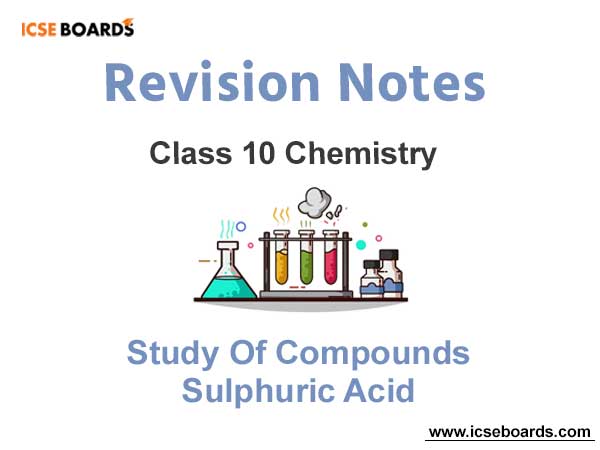ICSE Class 10 students can refer to ICSE Class 10 Study of Compounds Sulphuric Acid Notes given below which have been prepared as per the latest syllabus and guidelines issued by ICSE Board. All chapter wise revision notes for ICSE Class 10 Chemistry have been prepared by teachers have strong understanding of Chemistry. Read the notes prior to the exams to get better marks in exams
Study of Compounds Sulphuric Acid ICSE Class 10 Chemistry Revision Notes
Students can refer to the quick revision notes prepared for Chapter Study of Compounds Sulphuric Acid in Class 10 ICSE. These notes will be really helpful for the students giving the Chemistry exam in ICSE Class 10. Our teachers have prepared these concept notes based on the latest ICSE syllabus and ICSE books issued for the current academic year.
Revision Notes ICSE Class 10 Chemistry Study of Compounds Sulphuric Acid
Please refer to the detailed notes below
Sulphuric Acid

General Methods of Preparation
• By the action of heat on nitric acid and sulphur.
S + 6HNO3 → 6NO2 + 2H2O + H2SO4
• By passing chlorine through an aqueous solution of sulphur trioxide.
Cl2 + SO2 + 2H2O →2HCl + H2SO4
• By dissolution of sulphur trioxide in water.
SO3 + H2O →H2SO4
• By hydrolysis of sulphuryl chloride.
SO2Cl2 + 2H2O →H2SO4 + 2HCl
Manufacture of Sulphuric Acid [Contact Process]
Steps involved in the contact process
(1) Production of sulphur dioxide
SO2 is produced by roasting metallic sulphides in air.
4FeS2 +11O2 → 2Fe2O3 + 8SO2
(2) Purification of gases
To enhance the efficiency of a catalyst, various impurities present in the mixture of sulphur dioxide and air
are first removed.
(3) Catalytic oxidation of sulphur dioxide
Oxidation of SO2 to SO3 at 450°C in the presence of catalyst vanadium pentaoxide.

(4) Absorption of sulphur trioxide in sulphuric acid
Sulphur trioxide vapours are absorbed by a stream of conc. sulphuric acid.
SO3 + H2SO4 → H2S2O7 (oleum or pyrosulphuric acid)
(5) Dilution of oleum to obtain sulphuric acid
A calculated amount of water is added to obtain sulphuric acid of desired strength.
H2S2O7 + H2O → 2H2SO4
Properties of Sulphuric Acid
(A) Physical Properties
• Colourless, odourless with slight sour taste.
• It is highly corrosive in nature and chars the skin black.
• It is heavier than water and soluble in water.
• Boiling point is 338°C, and melting point is 10.4°C.
(B) Chemical Properties
Properties of Dilute Sulphuric Acid
• Dilute sulphuric acid reacts with metals to form metallic sulphate and hydrogen.
Mg + H2SO4 → MgSO4 + H2
Fe + H2SO4 → Fe2SO4 + H2
• It neutralises bases to form salts and water.
NaOH + H2SO4 →NaHSO4 + H2O
• It liberates carbon dioxide from metallic carbonates and bicarbonates.
Na2CO3 + H2SO4 → Na2SO4 + H2O + CO2
2KHCO3 + H2SO4 →K2SO4 + 2H2O +2CO2
• It evolves hydrogen sulphide from metal sulphides.
Na2S + H2SO4 →Na2SO4 + H2S
ZnS + H2SO4 →ZnSO4 +H2S
• It evolves sulphur dioxide from sulphites and hydrogen sulphites.
Na2SO3 +H2SO4 → Na2SO4 + H2O + SO2
2NaHSO3 +H2SO4 → Na2SO4 + 2H2O + 2SO2
Properties of Conc. Sulphuric Acid
• Non-volatile nature
It has a high boiling point so it is used to prepare volatile acids such as HCl, HNO3 and acetic acid
from their salts.
NaCl + H2SO4 →NaHSO4 + HCl
NaNO3 + H2SO4 →NaHSO4 + HNO3
• As an oxidising agent
C + 2H2SO4 → CO2 + 2H2O +2SO2
Cu + 2H2SO4 → CuSO4 + 2H2O +SO2
2HBr + H2SO4 →Br2 + 2H2O + SO2
• As a dehydrating agent
H2SO4 has a great affinity for water, and therefore, it acts as a dehydrating agent.

Uses of Sulphuric Acid
• In the preparation of halogens, CO, CO2 and SO2.
• Extraction of metals: Leaching of metallic compounds produces sulphates which give the metal in pure
form on electrolysis.
• Pickling of metals: Removes metallic impurities from the surface of metals before galvanising.
• Industrial uses:
i. In the manufacture of fertilisers such as ammonium sulphate [(NH4)2SO4] and superphosphate of
lime [Ca (H2PO4)2 +CaSO4].
ii. In the manufacture of explosives such as trinitrotoluene and picric acid.



